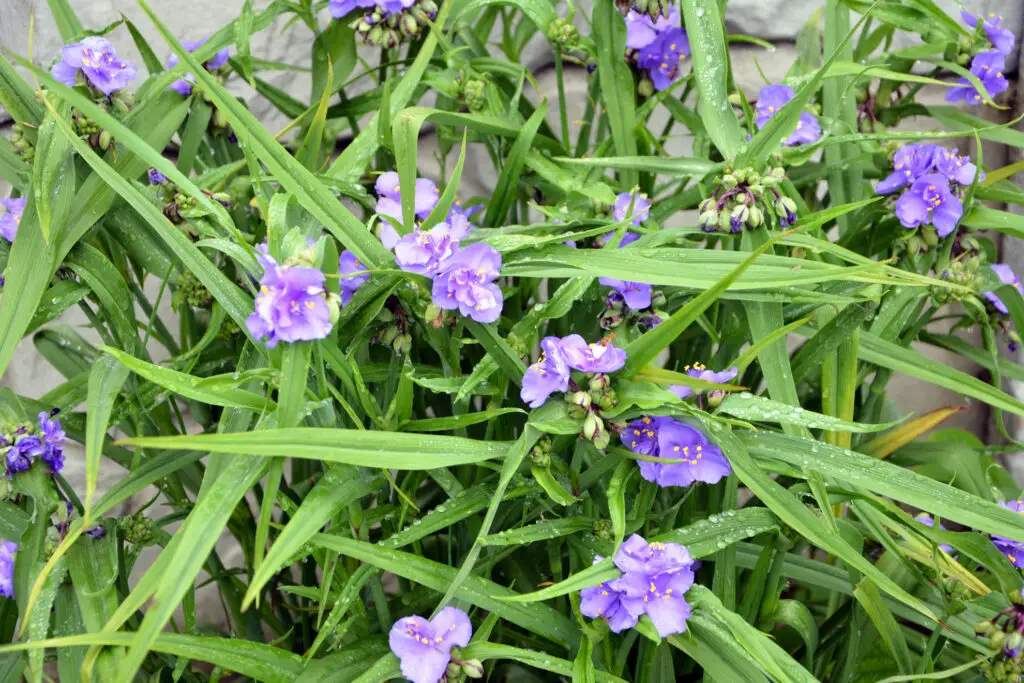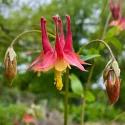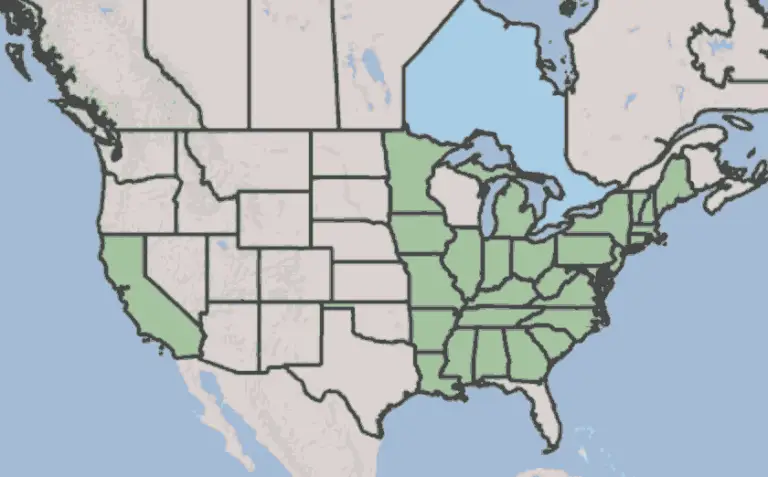Highlights
What an offputting common name for a sculptural pollinator favorite. Spiderwort sends up tall, bright-green stems and leaves, then nestles fistfuls of blue-purple flowers at the top. You’ll see blooms in the spring and into early summer. Pair with fall flowers (like asters and penstemons) for a pollinator-friendly, flower-filled garden. There are 10+ native Spiderwort species found in North America—scroll on to meet two easy-to-find favorites.

Dig Deeper
Explore the history, types, and where to plant native Spiderwort
Table of Contents
First off, you are probably thinking…
Why is it called Spiderwort?
Spiderwort is this plant’s common name, which is a name given by the generations before us—and usually penned by early European colonists. Often, these long-ago copywriters were simply dreadful—Spiderwort is an example of one common name that makes this beautiful flower seem sinister.
The name Spiderwort refers to what happens when you cut into the plant. According to the Missouri Botanical Garden, when spiderwort is cut, a “viscous stem secretion is released which becomes threadlike and silky upon hardening (like a spider’s web).”
Wow.
It’s named for something that no one even sees—unless the plant is cut open.
Thanks for nothing, whoever picked this sad common name! We’ve added Spiderwort to our round-up of Beautiful Native Plants with Terrible Common Names. We strongly believe we should change this plant’s common name to Cobalt Fireworks in our lifetimes.

Let’s put the common name aside and dive into this plant’s benefits.
What are the benefits of planting Spiderwort?
There are many, including:
- Long bloom-time. Expect 4-6 weeks of flowers from spring to early summer.
- Happy with sun to part sun. This wide range of sunlight makes it perfect for beginner gardeners. (Although the sunnier the spot, the more butterflies you’ll attract.)
- Dry to moist soil. As long as it’s not water-logged, this plant will be happy.
- Loam to clay soil. No stress here—Spiderwort can handle a range of soils.
- Deer-resistant. Deer leave this plant alone!
Where is Spiderwort native?
It depends on the species! The USDA Plants Database lists 10+ species of Spiderwort native to North America. There are Spiderworts native to just Texas, and other species native to the eastern half of the United States. As you can imagine, some of these native species are very difficult to find at plant nurseries.
We’ll focus on two species commonly found at native plant nurseries: Virginia Spiderwort and Ohio Spiderwort. In terms of greenery and flower color, both plants look identical.
Now you’re probably wondering—which one should I plant? Does it matter?
The Plant Native believes that native gardening should not feel like a botany exam. As you can see from the enormous native ranges, each of these commonly found Spiderwort species thrives in a vast swath of North America. So let’s put the species names aside for a moment.
A better way to ‘pick’ a Spiderwort species is to find a source for the plant that’s close to you. We call this the 800-mile plant tip. Since most Spiderworts look and behave the same, the best thing you can do is find plants with DNA that is best suited for your home area.
Plant ‘provenance’ is a secret advantage for gardens
As you can imagine, a Virginia Spiderwort with a family tree from New Hampshire will have much different DNA than a Spiderwort from Georgia. The area where a plant’s DNA is from is called its provenance.
Provenance takes hundreds of years—or even thousands of years—to establish. Multiple generations of a plant must grow and evolve for the DNA to build resilience and knowledge of its home area.
Use this secret to your advantage and plant the most locally-grown Spiderwort you can—regardless of the species. We’ve made this easy in our Resources section. Find your state’s native plant society, visit native plant nurseries, and buy online from close sources. (Using local sources is one of those ‘tricks’ that professional landscapers use to ensure their work is resilient and beautiful.)
To sum up plant provenance with a silly rhyme (sometimes it helps us remember!)
Local blooms, fewer glooms
Try to find plants and seeds from within 800 miles of where you live.
Plants and seeds from within 800 miles are best suited for your weather, water, and sunshine. This also fosters cross-pollination among locally grown plants, enhancing the resilience of seeds and plants for generations to come. Stay local for a happy garden!

Spiderwort is a hummingbird and butterfly favorite
Spiderwort flowers are an excellent nectar source for hummingbirds and butterflies. Butterflies love to warm their bodies up in the sun, so planting Spiderwort in sunnier areas will help maximize butterfly sightings.
Speaking of flowers…
Each spiderwort flower bud blooms for a single day. But don’t worry—each flower has so many buds that this singular bloom timing helps the plant appear in flower for weeks.
How to get Spiderwort to flower twice
There are a few native flowers that offer bloom times twice a year (the shade-favorite Celandine Poppy also comes to mind). To get Spiderwort to flower twice:
- Cut the greenery to the ground after the flowers bloom the first time.
- New greenery will reappear, and the plant will start its growing journey again.
- Expect a second flowering in the late summer / early fall.
How does Spiderwort spread?
Spiderwort spreads by sending roots outward and having plants grow up from there—these are called stolons. (This is how strawberries spread, too.) Plant a few Ohio or Virginia Spiderworts and watch them slowly spread in your garden over the years.
To keep them from spreading, dig them up, divide the plant (give the extra plant bits to neighbors and friends!), and replant the smaller pieces.
What are good pairings for Spiderwort?
Pair Spiderwort with native flowers that bloom at other parts of the season, like native penstemons and fall-blooming asters.
And that sums up our profile of Spiderwort! Let’s put this dreadful common name aside and plant this native flower in our gardens. Pair it with flowers that bloom throughout the rest of the summer into fall so that your garden looks amazing and pollinators always have something to snack on. Since Spiderwort is so forgiving of soils—clay, loam—and sunshine—full sun, part sun—it is a perfect native flower for beginner gardeners. Happy planting!
Sources
- Holland, Jonah. Lewis Ginter Botanical Garden, Spiderwort: Why is it called that anyway? June 6, 2014.
- Missouri Botanical Garden, Spiderwort
- USDA Plants Database, Spiderwort







